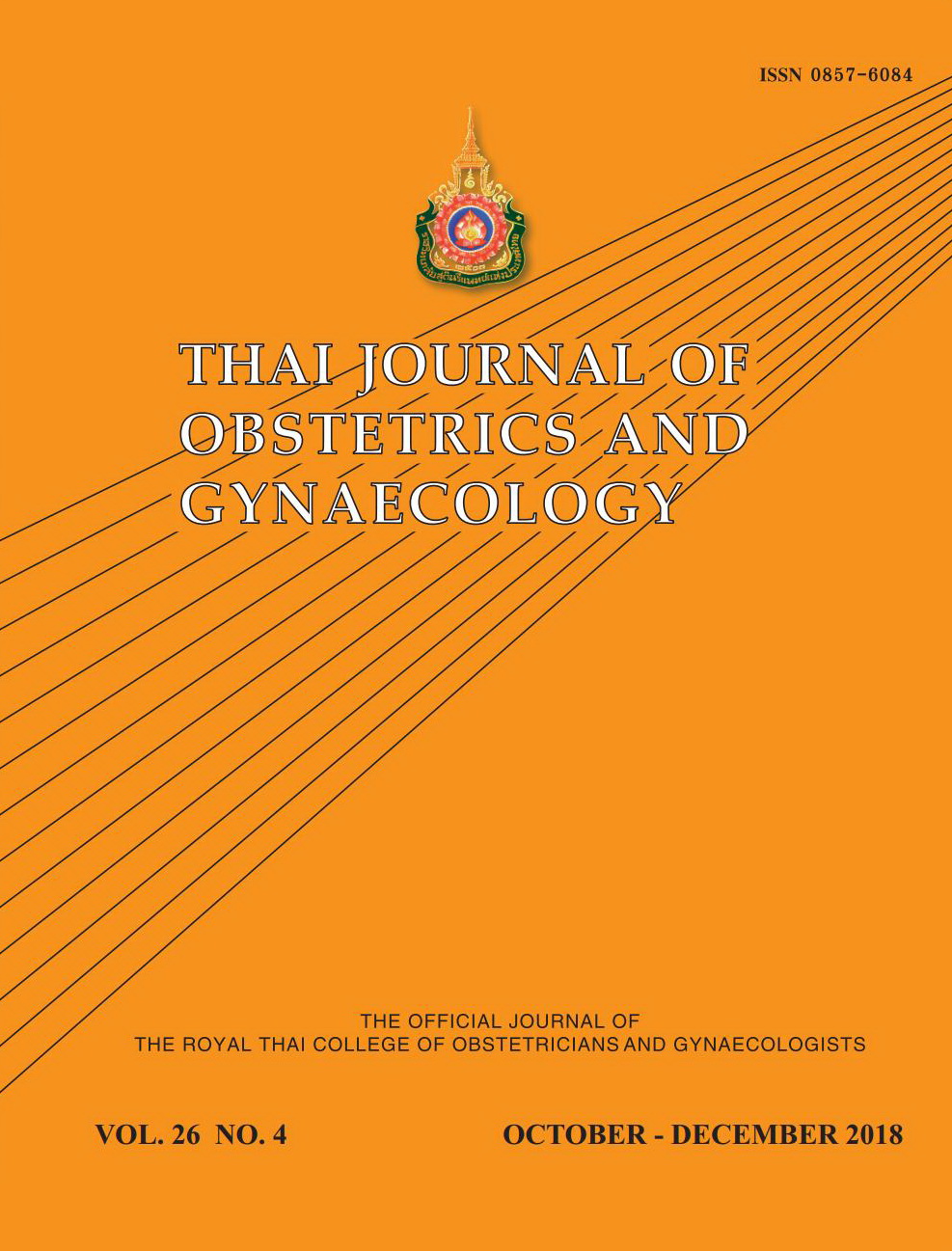Third Trimester Reference Values of Amniotic Fluid Index in a Group of Healthy Nigerian Women in Jos, Nigeria
Main Article Content
Abstract
Objectives: To ascertain the normal values of amniotic fluid index in third trimester among Nigerian women with uncomplicated singleton pregnancies in Jos, Nigeria.
Materials and Methods: This was a prospective cross-sectional study among 500 healthy pregnant women. Fifty women each were recruited at two-weekly interval from 28-36 weeks’ gestation and then weekly up to 41 weeks’ gestation. The uterine cavity was divided into four quadrants and using real-time ultrasonography, the vertical diameter of the largest pool of amniotic fluid was measured and summation of the values gave the amniotic fluid index (AFI). Mean, ranges, 5th, 10th, 50th, 90th and 95th percentiles for each gestational age were calculated using SPSS version 20 (IBM, Armonk, NY, USA).
Results: Mean AFI among the entire study population was 18.1±3.1 cm (range of 10.4-26.8 cm) while the mean AFI for preterm and term pregnancies were 18.5±2.6 cm and 17.8±3.5 cm respectively. The AFI reference range for the study population was 13.6-24.6 cm. Amniotic fluid volume was highest at 28 weeks, stabilized and plateau between 37-39 weeks and declined after 40 weeks’ gestation. Using 5th and 95th percentile as lower and upper limits of normal, reference ranges for each gestational age was ascertained.
Conclusion: Third trimester reference ranges of AFI is established and this can be used as a guide for evaluation of amniotic fluid volume in this obstetric population.
Keywords: amniotic fluid index, pregnancy, reference ranges, Nigeria
Article Details
References
2. ACOG practice Bulletin Number 145. Antepartum fetal surveillance, July 2014. Obstet Gynecol 2014; 124:182-92.
3. Preboth M. ACOG Guidelines on antepartum fetal surveillance. Am Fam Physician 2000;62:1184-8.
4. Callen WP. Amniotic Fluid Volume: Its role in fetal health and disease. In: Callen WP, ed. Ultrasonography in Obstetrics and Gynaecology. Philadelphia: Saunders, 2008:758-79.
5. Umar AA, Akano AO, Awosanya GOG, Lagundoye SB. Maximum Vertical Pocket measurement of Amniotic fluid volume. Arch Nigeria Med Med Sci 2004;1:1-4.
6. Chama CM, Bobzom DM, Mai MA. A longitudinal study of amniotic fluid index in normal pregnancy in Nigerian women. Int J Gynecol Obstet 2001;72:223-7.
7. Schrimmer DB, Moore TR. Sonographic evolution of amniotic fluid volume. Clin Obstet Gynaecol 2002; 45:1026-38.
8. Phelon JP, Ahn M, Smith CU, Rutherford SE. Amniotic fluid index in normal human pregnancies. Report Med 1987;32:601-4.
9. Moore TR, Cayle JE: The amniotic fluid index in normal human pregnancy. Am J Obstet Gynecol 1990; 62:1168-73.
10. Phelan JP, Ahn MO, Smith CV, Rutherford SE, Anderson E. Amniotic fluid index measurements during pregnancy. J Reprod Med 1987;32:601-4.
11. Birang SH. Ultrasonographic assessment of normal amniotic fluid Index in a group of Iranian Women. Iran J Radiol 2008;5:3-4.
12. Samakeenit B, Saksiriwuttho P, Ratanasiri T, Komwilaisak R. Amniotic Fluid Index (AFI) for Normal Pregnant Women in Northeastern Thailand. Thai J Obstet Gynaecol 2015;23:12-7.
13. Agwu EJ, Ugwu AC, Shem SL, Abba M. Relationship of amniotic fluid index (AFI) in third trimester with fetal weight and gender in a southeast Nigerian population. Acta Radiologica Open 2016;5:1-5.
14. Mongelli M, Ho WC, TambyRaja R. Amniotic fluid and maternal characteristics in Chinese pregnancies dated by early ultrasound biometry. Int J Obstet Gynecol 1999; 66:39-40.
15. Igbinidu E, Akhigbe AO, Akinola RA. Sonographic evaluation of the Amniotic Fluid Index in normal singleton pregnancies in a Nigerian population. IOSR J Dent Med Sci 2013;6:29-33.
16. Kofinas A, Kofinas G. Differences in amniotic fluid patterns and fetal biometric parameters in third trimester pregnancies with and without diabetes. J Matern Fetal Neonatal Med 2006;19:633-8.
17. Rabinowitz R, Peters MT, Vyas S, Campbell S, Nicolaides KH. Measurement of fetal urine production in normal pregnancy by real- time ultrasonography. Am J Obstet Gynecol 1989;161:1264-6.
18. Magann EF, Sandlin AT, Ounpraseuth ST. Amniotic fluid and the clinical relevance of the sonographically estimated amniotic fluid volume: Oligohydramnios. J Ultrasound Med 2011;30:1573-85.
19. Ali HS. Assement of amniotic fluid index in normal pregnancy at a tertiary care hospital setting. J Ayub Med Coll Abbottabad 2009;21:149-51.
20. Alao O, Ayoola O, Adetiloye V, Aremu A. The Amniotic fluid index in normal human pregnancies in Southwestern Nigeria. Internet J Radiol 2006;5:1-4.
21. Khadilkar SS, Desai SS, Tayade SM, Purandare CN. Amniotic fluid index in normal pregnancy: An assessment of gestation specific reference values among Indian women. J Obstet Gynaecol Res 2003;29:136-41.
22. Anand RS, Singh P, Sangal R, Srivastava R, Sharma NR, Tiwari HC. Amniotic fluid index, non-stress test and color of liquor: as a predictor of perinatal outcome. Int J Reprod Contracept Obstet Gynecol 2016;5:3512-7.
23. Magann EF, Chauhan SP, Hitt WC, Dubil EA, Morrison JC. Borderline or Marginal amniotic fluid Index and peripartum outcomes. J Ultrasound Med 2011;30: 523-8.
24. Jeng CJ, Lee JF, Wang KG, Yang YC, Lan CC. Decreased amniotic fluid index in term pregnancy: Clinical significance. J Reprod Med 1992;37:789-92.
25. Lu SC, Chang CH, Yu CH, Chang FM. Reappraisal of normal amniotic fluid index in an Asian population: analysis of 27,088 records. Taiwan J Obstet Gynecol 2007;46:260-3.

